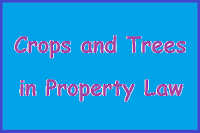Hello Reader, this time Tabir Hukum will discuss about crops and trees in property law.
Crops, although they too are attached to the land, are not considered fixtures because their attachment to the land is intended to be temporary. Emblements is the legal term for growing crops annually produced by the labour of the cultivator. Even before harvest, while the crops are still attached to the land - and indeed, even before they are planted - the landowner can transfer rights to the crop without transferring rights to the land itself. Thus, the landowner can obtain a loan for planting a crop and give the creditor an interest in the crop as security for the loan. In general, a growing crop is treated as a chattel and not part of the real property, but a transfer of land transfers rights to any standing crop on the land, unless the owner of the land no longer owns the crop, or unless the crop is specifically excluded from the property being transferred.
Trees remain rooted to the land for much longer than emblements, and are, like crops, treated as part of the land in a transfer of a freehold estate. In England, where most of our common law rules originated individual trees as well as a managed forest could be a significant part of the value of the estate, and a person who holds a life estate is constrained by the doctrine of waste, from harvesting trees beyond what is necessary to meet reasonable needs for fuel and shelter. In the colonies, where the first objective of many settlers was clearing the land in order to plant crops, judges were willing to reconceptualize how much tree-cutting would maintain a reasonable balance between the competing ownership rights of the life tenant and the person entitled to possession of the fee simple when the life tenant died.
Not uncommonly, people plant trees to mark the boundary lines of their property, and, as these grow and spread, their presence may occasion disputes over who has the right to cut them. If the trunk of the tree emerges from the ground entirely on A's property, A has the right to cut the tree, but not to trespass on a neighbour's land to do so. B, the neighbour, has the right to cut the branches that overhang on B's property. Some decisions suggest further that B has the right to cut away any part of a tree trunk that is on B's land, without A's permission and without liability A if the tree dies. Prudent people, however, obtain agreement from their neighbours before interfering with a tree whose ownership is not entirely clear. Why risk being the defendant in the case that clarifies the law to the benefit of the plaintiff ?.
Umpteen posts of tabir hukum about crops and trees in property law, hopefully the writing of tabir hukum about crops and trees in property law can be beneficial.
Books : In Writing Tabir Hukum :
Alan M. Sinclair and Margaret E. McCallum, 2005. An Introduction to Real Property Law (Fifth Edition). LexisNexis : Canada.



